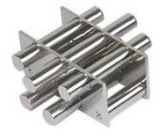Neodymium may be a rare-earth element metal component mischmetal
which may be wont to create powerful magnets. Neodymium magnets are the
strongest known relative to their mass, with even small magnets ready to
support thousands of times their own weight. Although a “rare” earth metal,
neodymium is widely available, resulting in easily obtainable raw materials to
manufacture neodymium
magnets. Due to their strength, neodymium magnets are utilized in a
broad range of applications, including jewelry, toys, and computer equipment.
As neodymium magnets are so strong, their uses are versatile.
They’re produced for both commercial and industrial needs. For instance,
something as simple as a bit of magnetic jewelry uses a neo to stay the earring
in situ. At an equivalent time, neodymium magnets are being sent into space to
assist collect dust from the surface of Mars. Neodymium magnets’ dynamic
capabilities have even because they getting used in experimental levitation
devices.
Neodymium Magnet
Neodymium magnets also referred to as NIB magnets, are measured
from N24 to N55 on the magnetism scale that goes up to N64, which may be a
theoretical magnetism measurement. Counting on the form, the composition, and
therefore the production method, NIB magnets can fall anywhere during this
range and supply serious lifting strength.
In order to construct a neo, as they're sometimes also called,
manufacturers collect rare-earth element metals and sift them to seek out
usable Neodymium
Magnets, which they need to break away other minerals. This neodymium
is ground up into a fine powder, which may then be resealed into the desired
shape once combined with iron and boron. Thanks to the iron during a neo, its
properties almost like other ferromagnetic materials, including mechanical
fragility.
Neos also are vulnerable to temperature differences and may crack
or lose their magnetism in higher temperatures, usually above 176 degrees
Fahrenheit. Some specialized neos work on higher temperatures, but generally
above that level, they fail to properly function. In cooler temperatures, neos
are going to be fine. Because other sorts of magnets don’t lose their magnetism
at these high temperatures, neos are often bypassed for applications that will
be exposed to great amounts of warmth.


